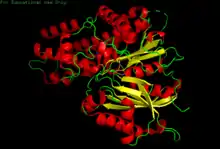جایگاه اتصال
جایگاه اتصال در بیوشیمی و زیستشناسی مولکولی، ناحیه ای بر روی درشتمولکول مانند پروتئینی است که با ویژگی خاص به مولکول دیگری متصل میشود.[1] شریک اتصال ماکرومولکول اغلب به عنوان لیگاند شناخته میشود.[2] لیگاندها ممکن است شامل سایر پروتئینها (در نتیجه تعامل پروتئین و پروتئین)،[3] بسترهای آنزیمی، پیام رسانهای دوم، هورمونها یا تعدیل کنندههای آلوستریک باشند. رویداد اتصال غالباً، اما نه همیشه، با یک تغییر شکل ساختاری همراه است که عملکرد پروتئین را تغییر میدهد.[4] اتصال به محلهای اتصال پروتئین اغلب برگشتپذیر (گذرا و غیر کووالانسی) است، اما همچنین میتواند برگشتپذیر کووالانسی باشد[5] یا غیرقابل برگشت است.

انواع
کاربردها
اختلافات بیوشیمیایی موجودات مختلف با انسان برای ایجاد دارو مفید است. به عنوان مثال، پنی سیلین با مهار DD-transpeptidase، تخریب توسعه دیواره سلول باکتریایی و ایجاد مرگ سلولی، آنزیمهای باکتریایی را از بین میبرد؛ بنابراین، مطالعه مکانهای اتصال به بسیاری از زمینههای پژوهشی از جمله مکانیسمهای سرطان،[6] فرمولاسیون دارو،[7] و تنظیم فیزیولوژیکی مربوط است.[8] فرمولاسیون یک بازدارنده برای متوقف کردن کارکرد یک پروتئین، یک شکل رایج از درمان دارویی است.[9]
منابع
- "Binding site". Medical Subject Headings (MeSH). U.S. National Library of Medicine.
The parts of a macromolecule that directly participate in its specific combination with another molecule.
- "Ligands". Medical Subject Headings (MeSH). U.S. National Library of Medicine.
A molecule that binds to another molecule, used especially to refer to a small molecule that binds specifically to a larger molecule.
- Amos-Binks A, Patulea C, Pitre S, Schoenrock A, Gui Y, Green JR, Golshani A, Dehne F (June 2011). "Binding site prediction for protein-protein interactions and novel motif discovery using re-occurring polypeptide sequences". BMC Bioinformatics. 12: 225. doi:10.1186/1471-2105-12-225. PMC 3120708. PMID 21635751.
- Spitzer R, Cleves AE, Varela R, Jain AN (April 2014). "Protein function annotation by local binding site surface similarity". Proteins. 82 (4): 679–94. doi:10.1002/prot.24450. PMC 3949165. PMID 24166661.
- Bandyopadhyay A, Gao J (October 2016). "Targeting biomolecules with reversible covalent chemistry". Current Opinion in Chemical Biology. 34: 110–116. doi:10.1016/j.cbpa.2016.08.011. PMC 5107367. PMID 27599186.
- Spitzer R, Cleves AE, Varela R, Jain AN (April 2014). "Protein function annotation by local binding site surface similarity". Proteins. 82 (4): 679–94. doi:10.1002/prot.24450. PMC 3949165. PMID 24166661.
- Peng J, Li XP (November 2018). "Apolipoprotein A-IV: A potential therapeutic target for atherosclerosis". Prostaglandins & Other Lipid Mediators. 139: 87–92. doi:10.1016/j.prostaglandins.2018.10.004. PMID 30352313.
- McNamara JW, Sadayappan S (December 2018). "Skeletal myosin binding protein-C: An increasingly important regulator of striated muscle physiology". Archives of Biochemistry and Biophysics. 660: 121–128. doi:10.1016/j.abb.2018.10.007. PMC 6289839. PMID 30339776.
- Widemann BC, Adamson PC (June 2006). "Understanding and managing methotrexate nephrotoxicity". The Oncologist. 11 (6): 694–703. doi:10.1634/theoncologist.11-6-694. PMID 16794248.
پیوند به بیرون
- Binding Sites در سرعنوانهای موضوعی پزشکی (MeSH) در کتابخانهٔ ملی پزشکی ایالات متحدهٔ آمریکا
- ترسیم محل فعال آنزیم